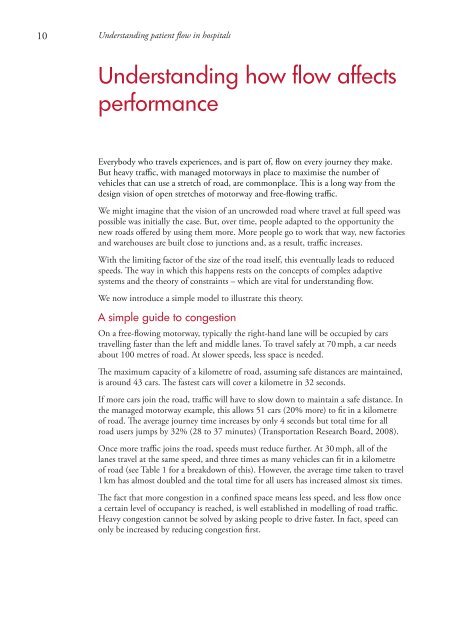Understanding patient flow in hospitals
understanding_patient_flow_in_hospitals_web_0
understanding_patient_flow_in_hospitals_web_0
You also want an ePaper? Increase the reach of your titles
YUMPU automatically turns print PDFs into web optimized ePapers that Google loves.
10 <strong>Understand<strong>in</strong>g</strong> <strong>patient</strong> <strong>flow</strong> <strong>in</strong> <strong>hospitals</strong><br />
<strong>Understand<strong>in</strong>g</strong> how <strong>flow</strong> affects<br />
performance<br />
Everybody who travels experiences, and is part of, <strong>flow</strong> on every journey they make.<br />
But heavy traffic, with managed motorways <strong>in</strong> place to maximise the number of<br />
vehicles that can use a stretch of road, are commonplace. This is a long way from the<br />
design vision of open stretches of motorway and free-<strong>flow</strong><strong>in</strong>g traffic.<br />
We might imag<strong>in</strong>e that the vision of an uncrowded road where travel at full speed was<br />
possible was <strong>in</strong>itially the case. But, over time, people adapted to the opportunity the<br />
new roads offered by us<strong>in</strong>g them more. More people go to work that way, new factories<br />
and warehouses are built close to junctions and, as a result, traffic <strong>in</strong>creases.<br />
With the limit<strong>in</strong>g factor of the size of the road itself, this eventually leads to reduced<br />
speeds. The way <strong>in</strong> which this happens rests on the concepts of complex adaptive<br />
systems and the theory of constra<strong>in</strong>ts – which are vital for understand<strong>in</strong>g <strong>flow</strong>.<br />
We now <strong>in</strong>troduce a simple model to illustrate this theory.<br />
A simple guide to congestion<br />
On a free-<strong>flow</strong><strong>in</strong>g motorway, typically the right-hand lane will be occupied by cars<br />
travell<strong>in</strong>g faster than the left and middle lanes. To travel safely at 70 mph, a car needs<br />
about 100 metres of road. At slower speeds, less space is needed.<br />
The maximum capacity of a kilometre of road, assum<strong>in</strong>g safe distances are ma<strong>in</strong>ta<strong>in</strong>ed,<br />
is around 43 cars. The fastest cars will cover a kilometre <strong>in</strong> 32 seconds.<br />
If more cars jo<strong>in</strong> the road, traffic will have to slow down to ma<strong>in</strong>ta<strong>in</strong> a safe distance. In<br />
the managed motorway example, this allows 51 cars (20% more) to fit <strong>in</strong> a kilometre<br />
of road. The average journey time <strong>in</strong>creases by only 4 seconds but total time for all<br />
road users jumps by 32% (28 to 37 m<strong>in</strong>utes) (Transportation Research Board, 2008).<br />
Once more traffic jo<strong>in</strong>s the road, speeds must reduce further. At 30 mph, all of the<br />
lanes travel at the same speed, and three times as many vehicles can fit <strong>in</strong> a kilometre<br />
of road (see Table 1 for a breakdown of this). However, the average time taken to travel<br />
1 km has almost doubled and the total time for all users has <strong>in</strong>creased almost six times.<br />
The fact that more congestion <strong>in</strong> a conf<strong>in</strong>ed space means less speed, and less <strong>flow</strong> once<br />
a certa<strong>in</strong> level of occupancy is reached, is well established <strong>in</strong> modell<strong>in</strong>g of road traffic.<br />
Heavy congestion cannot be solved by ask<strong>in</strong>g people to drive faster. In fact, speed can<br />
only be <strong>in</strong>creased by reduc<strong>in</strong>g congestion first.



